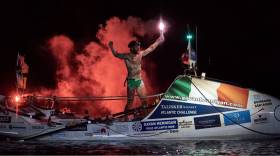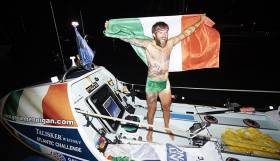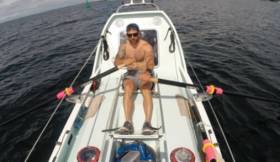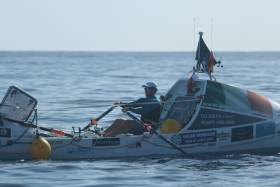Displaying items by tag: Gavan Hennigan
Another Record Achievement for Galway Ocean Rower Gavan Hennigan — This Time on Foot in Alaska
Gavan Hennigan, a 42-year-old native of Galway who completed a solo row of the Atlantic in 2017, has become the first Irish person to not only complete but win a 1,000-mile foot race in Alaska.
This was achieved while experiencing gruelling weather conditions and extremely challenging terrain over 24 days.
Only approximately 50 athletes have completed the 1,000-mile Iditarod Trail Invitational within the 30 day cut-off period over the 18 years the event has been run.
Gavan is no stranger to the accomplishment of extreme challenges, however, as he previously won the 350-Mile Iditarod Trail foot race and completed a 5,000km solo row of the Atlantic in the Takisker Whisky Challenge in early 2017.
He crossed the finish line amid heavy snowfall in Nome, Alaska in first place with a time of 24 days, 18 hours and nine minutes, completing what race organisers have called a “monumental achievement”.
Gavan Hennigan To Embark On Another Atlantic Solo Row This Summer
#Rowing - Record-setting ocean rower Gavan Hennigan is getting set to do it all over again this summer, with plans for a solo crossing from New York to Galway Bay.
Afloat.ie’s Rower of the Month for January made the announcement on last night’s Late Late Show, just days after returning home, as host Ryan Tubridy quizzed the Galway man on his motivations for embarking on the Talisker Whisky Atlantic Challenge.
The 35-year-old finished third in the 12-boat fleet, fending off teams with greater man-power to complete the 5,000km crossing from the Canary Islands to Antigua in the West Indies in 49 days.
The tremendous achievement earlier this month is a far cry from where Hennigan was in his early 20s, jobless and drowning his sorrows in an East London flat after a difficult childhood.
Hennigan turned his life around on a year’s working holiday in Australia, where he qualified as a commercial diver, and spent the next 10 years working as a deep-sea saturation diver specialising in construction of oil rigs around the globe — “the most dangerous job in the world”, in his own words.
But it was a career perfectly suited to Hennigan’s adventurous spirit, and when the ‘extreme environment athlete’ announced last year that he would attempt a solo row across the Atlantic, the news was no surprise to those who know him.
“I was seeking a little bit more excitement, and I just decided I wanted to take more of a gamble with my life,” he told Tubridy.
Hennigan was well up to the task over years of embarking on endurance expeditions in his spare time, such as a solo trek across Lake Baikal in Siberia, and numerous ultra-marathons in extreme conditions.
But taking part in the Talisker Whisky Atlantic Challenge meant going all-in.
“I spent my life’s savings on this ocean rowing boat, so now I’m trying to pass myself off as an adventurer and public speaker,” he said with a smile.
Talking about the “range of emotions” he went through while out on his own in the open ocean for more than seven weeks, he admitted “it’s pretty hard not to lose the plot a couple of times”.
Hennigan was also candid about the toll it took on him mentally and physically — facing 12 hours of darkness every night, often without the light of the moon, and at one point being forced to tape an oar to his hand after losing his grip strength.
Still, the memories were worth it, as he described the “beauty of 50 sunsets, 50 sunrises, all spectacularly different. Every day just looking at that ocean and the sky and stars, seeing the Milky Way in all its glory — it can’t but change a man, it’s incredible.”
So what’s next for Hennigan? Another solo ocean row, as it happens: this coming June he plans to row from Battery Park, at the tip of Manhattan in New York, across the North Atlantic to Galway Bay.
“This is a lot tougher,” he says of his latest exploit. “There’s no safety of the race set-up; it’s a very treacherous route, with huge storms and currents.
“This is another step altogether. But I feel I’m not going into it with my eyes closed.”
Gavan Hennigan’s Late Late Show interview is available to watch on RTÉ Player till Sunday 19 March.
Hennigan Home From Record-Breaking Row
#Rowing: Ocean rower Gavan Hennigan arrived in Dublin Aiport today to a warm welcome from family, friends and supporters. The Galway man, who rowed across the Atlantic from the Canaries to Antigua in a new record time for a solo oarsman for this course of 49 days 11 hours 37 minutes and 21 seconds, looked thin but healthy. “This is nice, but it is a huge contrast to what I was at ten days ago,” he said. Did he find it strange being on dry land? “Yes. I enjoy the trappings of the modern world, but I miss the sea.” He spoke of feeling that there was “unfinished business” on the ocean, though any new plans are under wraps.
One of the first to greet him was his mother, Julie. His mother’s father, John Egan, had been a Gaelic footballer with Castlebar Mitchels, and Hennigan took his grandfather’s medals with him on the ocean row for inspiration. John Egan captained three consecutive county senior championship winning teams, in 1930, 1931 and 1932.
Historic Ocean Rower Takes Over Ireland Twitter Account
#Rowing - Just days after completing his 5,000km solo row across the Atlantic, Gavan Hennigan has taken control of Ireland’s national Twitter account for a week.
On Monday 6 February, Hennigan — who normally tweets @soulogav — was given the keys to the @ireland account that’s been administered by WorldIrish for the last five years.
Afloat.ie’s Rower of the Month for January has been posting messages and images from Antigua in the Caribbean, where the fleet of competitors in the Talisker Whisky Atlantic Challenge continues to stream in.
But like the best @ireland hosts, he’s also engaging in conversation with the Twittersphere, most recently retweeting their photos of favourite places for adventure in Ireland.
Hennigan will continue to tweet from the Ireland account till this Sunday 12 February.
Ocean Rower Gavan Hennigan is Afloat Rower of Month
#Rowing: The Afloat Rower of the month for January is Gavan Hennigan. The Galway man set a new Irish record for a solo row across the Atlantic ocean. He crossed from La Gomera in the Canary Islands to Antigua in the West Indies in 49 days 11 hours 37 minutes and 21 seconds, the fastest solo row for this course. He finished a remarkable third in the 12-boat Talisker Whisky Atlantic Challenge. He beat all the boats except two fours and won a stirring battle with the three-man crew of American Oarsmen.
Rower of the Month awards: The judging panel is made up of Liam Gorman, rowing correspondent of The Irish Times, and David O'Brien, editor of Afloat magazine. Monthly awards for achievements during the year will appear on afloat.ie. Keep a monthly eye on progress and watch our 2017 champions list grow.
Irishman makes Ocean Rowing History, Gavan Hennigan Completes 5000km Solo Row Across the Atlantic Ocean
After 49 days on the water, Irishman Gavan Hennigan completed the 5,000km Talisker Whisky Atlantic Challenge in style as he broke Irish and International Ocean Rowing Records. As Afloat.iereported earlier, the solo rower bravely held off the challenge of a 3 man American team, to finish the race in 3rd place. 30 minutes was all that separated the two boats after 49 days of relentless ocean rowing, in what was an historically close finish.
Upon arrival at Antigua, the proud Irishman raised the Irish Tricolour to salute the large crowd gathered to watch him complete the race. An exhausted Gavan had this to say:
”I’m so proud to have done this. Not many Irish have attempted a Solo row across the Atlantic and I feel I've done it in style. I had so many messages of support. I’d get up some days… and I’d be struggling but when I read the positivity in those notes and comments... from complete strangers... that would motivate me to get back on the oars and do it for them. To do it for Ireland. The last 7 days have been relentless. At times, I’ve rowed up to 19 hours a day and yesterday when I woke up, I decided it was time to finish this. I’ve rowed for the past 14 hours straight. I gave that my all.
This has been a life changing experience. I’ve experienced the beauty of the Atlantic sunsets and sunrises, the thrill of open ocean row boat surfing, the despair of driving headwinds and the joy of arriving back on land today. For the past 49 days I’ve had one single goal. To live life. I’ve embraced every minute and I’m so happy to be here finally.I'd like to thank Talisker and Atlantic campaigns for giving me the opportunity to make this journey. I'll never forget it.”
 In breaking the 50 day mark, Hennigan set a new Irish Solo Atlantic Rowing Record. Photo: Ben Duffy
In breaking the 50 day mark, Hennigan set a new Irish Solo Atlantic Rowing Record. Photo: Ben Duffy
The race began on the island of la Gomera, a small island in the Canary Islands on December 14th and saw 12 boats take to the water. Irishman Gavan Hennigan was one of 4 solo entries and in finishing 3rd, Hennigan has seen off the challenges of all the solo entries, the teams of two and three along with a boat of four.
In breaking the 50 day mark, Hennigan set a new Irish Solo Atlantic Rowing Record and set a new International Course Record for the crossing from la Gomera to Antigua. The fastest Irish man to make the East to West crossing previously, was Sean McGowan who completed the crossing in 118 days in 2010. McGowan had technical difficulties during his race and finished with two broken oars. The fastest Irishman to make the West to East crossing was Tom McClean in 1987 who completed the crossing in 55 days. On the international front, the fastest recorded crossing on the course from la Gomera to Antigua was by Matteo Perruchini who completed the crossing in 52 days in 2016.
No stranger to extreme, endurance events, Gavan has completed Ultramarathons, Iron Man challenges and raced across a frozen lake in Siberia on foot. He has adventured to all seven continents raising money for local Galway charities, Cancer Care West and Jigsaw West, which this row was also in aid of.
Gavan burnt around 8,000 calories a day and lost approximately 20% of his body weight over the duration of the race, which started on 14th December 2016, from La Gomera in the Canary Islands. He endured tropical storms, sleep deprivation, sweltering heat and the psychological stresses of living and working in such an unpredictable environment. Through his achievement, Gavan has proven himself to be an astute tactician and a resilient, skilled and powerful ocean rower. He overcame not just the challenges faced by a solo competitior but he excelled in beating the chasing teams behind him. He has now made his mark on history and in the Ocean Rowing Society Records.
More about Gavan Hennigan:
Gavan Hennigan (35) – Ireland – Gavan Hennigan is an Irish Extreme Environment Athlete. He has adventured to all 7 continents, from Ultra Running at home in Ireland to Winter Ultras and snowboard mountaineering in the Antarctic. Gavan is raising money for Jigsaw Galway and Cancer Care West:
Battling Hennigan Covers 150 Kilometres in One Day
#Rowing: Gavan Hennigan is producing extraordinary mileage in his battle to be the next boat to finish the Talisker Whisky Atlantic Challenge. The solo oarsman has held third since early in the 12-boat race from the Canary Islands to Antigua in the West Indies. The two leading craft, Latitude 35 and Row for James have finished and in the battle to be next boat to finish Hennigan has come under serious pressure from the three-man crew of American Oarsmen, which closed on him and looked set to pass him. In recent days, with a switch to more favourable winds, Hennigan has stretched his slight lead. He has been covering over 70 nautical miles (130 kilometres) per day. On Monday he covered 81 nm (150 km) to 78nm (144 km) for American Oarsmen.
Solo Rower Hennigan Holds Off Three-Man Crew
#Rowing: Solo oarsman Gavan Hennigan and the three-man American Oarsmen are locked in a stirring battle for the lead in the Talisker Whisky Atlantic Challenge. With two four-men crews already finished, the Irishman, who took over in third early on, holds the top spot on the water in the 12-boat race. Crew boats made more progress in the past week as Hennigan encountered tricky conditions. American Oarsmen, who can row over the full day while Hennigan must take some rest, had looked set to reel him in on Thursday. However, Hennigan has upped his mileage to an impressive 62 nautical miles (115 kilometres) per day, exactly matching American Oarsmen. With about a week’s rowing left to the finish in Antigua, Hennigan’s lead is 12 nautical miles (22 km).
“I’m focused on controlling the controllables,” Hennigan said. “I know about American Oarsmen, but I can’t do anything about what they’re doing. I can only focus on rowing my boat and pushing myself to the limit to get to Antigua as fast as I possibly can.”
Wind Rows In Behind Hennigan
#Rowing: The winds have finally changed in his favour and Gavan Hennigan has been taking advantage to put distance between him and the challengers for the third place he holds in the Talisker Whisky Atlantic Challenge rowing race. On the 32nd day of the race from the Canaries to Antigua, Hennigan had 71 nautical miles (131 kilometres) to spare over the fourth-placed boat, Facing It. He is also travelling slightly faster. If he is to stay third in the 12-boat fleet he must make good time when the wind favours him, as his nearest challengers, Facing It and American Oarsmen, who both have three men rowing, can force their way through difficult winds 24 hours a day. Hennigan, who is a solo oarsman, must take some periods of rest. The top two crews, Latitude 35 and Row for James, have been struggling in tough winds and making much less mileage than they would like. Both are fours.
Hennigan Half Way to His Atlantic Goal
#Rowing: Irish oarsman Gavan Hennigan has crossed halfway on his row across the Atlantic Ocean. The Galway man has had a tough 36 hours, with northerly winds pushing him off his preferred course, but the winds are switching to a more easterly direction and he has already begun to up his rate of nautical miles per day. Hennigan has been holding third place in a race with 12 boats, just four of them solo craft. He reached the halfway mark going into the 25th day of the Talisker Whisky Atlantic Challenge, which runs from La Gomera in the Canary Islands to Antigua.




































































